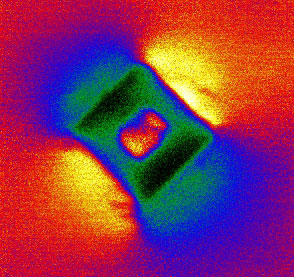| Posted: November 25, 2009 |
Chemists get custom-designed microscopic particles to self-assemble in liquid crystal |
|
(Nanowerk News) Chemists and physicists have succeeded in getting custom-shaped microparticles to interact and self-assemble in a controlled way in a liquid crystal.
|
|
The research, federally funded by the National Science Foundation, appears in the Nov. 20 edition of the journal Science.
|
|
"We're learning the rules about how these lithographic particles self-assemble," said Thomas G. Mason, a UCLA professor of chemistry and physics and a member of the California NanoSystems Institute at UCLA. "This method may enable us to cause them to assemble in desired configurations."
|
 |
| Is it chemistry or art? Both Polarized light microscopy image of a square microparticle in liquid crystal. An image taken using polarized light microscopy. Clayton Lapointe, Thomas G. Mason and Ivan Smalyukh have succeeded in getting custom-shaped particles to interact and assemble in a controlled way in a liquid crystal. The colors indicate the direction of alignment of rod-like molecules outside the square microparticle. (Image: Clayton Lapointe/UCLA Chemistry and Physics)
|
|
The scientists anticipate that their "LithoParticles," which are made of solid polymeric materials, will have significant technological and scientific uses.
|
|
"We're examining how pairs of particles interact and come to attach together," Mason said. "If we can get the particles to interact in certain controlled ways, we can build larger-scale assemblies that may have applications in photonics, optical communication networks and a variety of other areas."
|
|
Mason and his colleagues — lead author Clayton Lapointe, a postdoctoral scholar at UCLA, formerly at the University of Colorado at Boulder, and Ivan Smalyukh, an assistant professor of physics at the University of Colorado at Boulder — used an optical microscope to study the attractions between the particles, which they custom designed in various shapes, including triangles, squares and pentagons. The particles are too small to see with the unaided eye but are quite clear with the instrument.
|
|
"This is a very complex material that we have created," said Mason, whose research is at the intersection of chemistry, physics, engineering and biology. "We have made lithographic particles dispersed in a liquid crystal, and the molecular constituents are aligned."
|
|
Particles of different shapes interact in different ways, Lapointe, Mason and Smalyukh report. Those with an odd number of sides, such as triangles and pentagons, interact differently than particles shaped like squares.
|
|
"In this environment, the particles have different kinds of interactions that depend on their shapes," Mason said. "We have shown in a systematic way how by changing the number of sides of the particles in a controlled way, we can characterize the differences in their interactions."
|
|
The scientists added materials to the liquid crystal to get the particles to attract. They produced the geometric particles using the same method Mason and his UCLA used to design and mass-produce billions of fluorescent microscale particles in the shapes of all 26 letters of the alphabet, as well as geometric shapes, such as triangles, crosses and doughnuts, in 2007. Now they have watched the particles interact.
|
|
In another paper, UCLA postdoctoral scholar Kun Zhao and Mason report discovering new states of matter in two dimensions. Their research, which appears in the Nov. 13 edition of the journal Physical Review Letters, focused on a two-dimensional surface with pentagon-shaped particles that were free to move on this surface. Zhao and Mason studied the structures as they increased the area fraction of the pentagons in the confined two-dimensional plane. They used a lithographic technique to make the particles and studied them in water on a flat glass surface.
|

